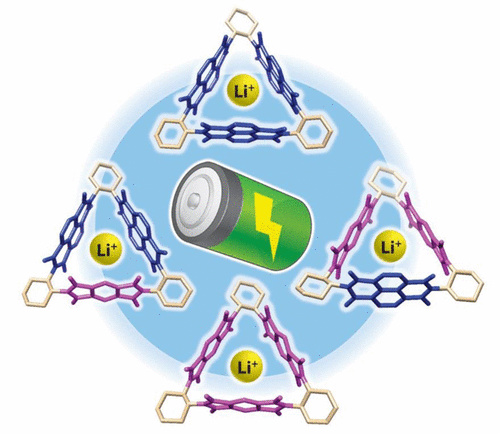Chiral Redox-Active Isosceles Triangles for Enhanced Organic Lithium-Ion Batteries
Web Published:
10/21/2025
NU 2016-043
INVENTORS
- J. Fraser Stoddart (Nobel laureate; Northwestern University, Weinberg College of Arts & Science, Department of Chemistry)*
- Siva Nalluri
- Zhichang Liu
SHORT DESCRIPTION
This technology uses chiral, redox-active isosceles triangles as active materials for organic rechargeable lithium-ion batteries. It offers improved redox properties and capacity performance for energy storage applications.
BACKGROUND

Current lithium-ion battery materials face challenges such as low capacity, limited cycling stability, and solubility issues that reduce long-term performance. High production costs and material degradation further drive the need for innovative organic battery materials that overcome these limitations.
ABSTRACT
The inventors developed two types of chiral isosceles triangles using stepwise condensation reactions. The triangles exhibit lower molecular symmetries and form 2D layer-like supramolecular structures. Cyclic voltammetry shows up to six accessible redox states. Battery tests reported capacities of 140.1 and 58.1 mAh g⁻¹. The performance improves with an increased number of subunits, providing insight into structure-performance relationships in organic rechargeable battery materials.
MARKET OPPORTUNITY
The global lithium-ion battery market was valued at $57.3 billion in 2023 and is projected to surge to $278.4 billion by 2033, expanding at a CAGR of 17.1% (Source: Precedence Research, 2024).
DEVELOPMENT STAGE
TRL-3, Experimental Proof-of-Concept Active R&D initiated: Laboratory tests have validated key electrochemical functions through cyclic voltammetry and battery performance analyses.
APPLICATIONS
- Organic rechargeable lithium-ion batteries: Active materials for improved battery performance.
- Energy storage systems: Suitable for sustainable, low-cost energy storage.
- Portable electronics: Enhances battery life and efficiency in mobile devices.
ADVANTAGES
- Multiple redox states: Provides access to six distinct oxidation levels.
- Enhanced capacity: Achieves up to 140.1 mAh g⁻¹ in battery testing.
- Improved cycling stability: Delivers consistent performance during charge/discharge cycles.
- Tunable performance: Capacity increases with additional NDI subunits.
PUBLICATIONS
IP STATUS
Issued US Patent (US11155554B2)
Patent Information:
| Title |
App Type |
Country |
Serial No. |
Patent No. |
File Date |
Issued Date |
Expire Date |
Categories:
Physical Sciences > Materials and Industrial Processes
Physical Sciences > Energy & Sustainability
Keywords:
Batteries
Energy storage
Lithium-ion
Materials